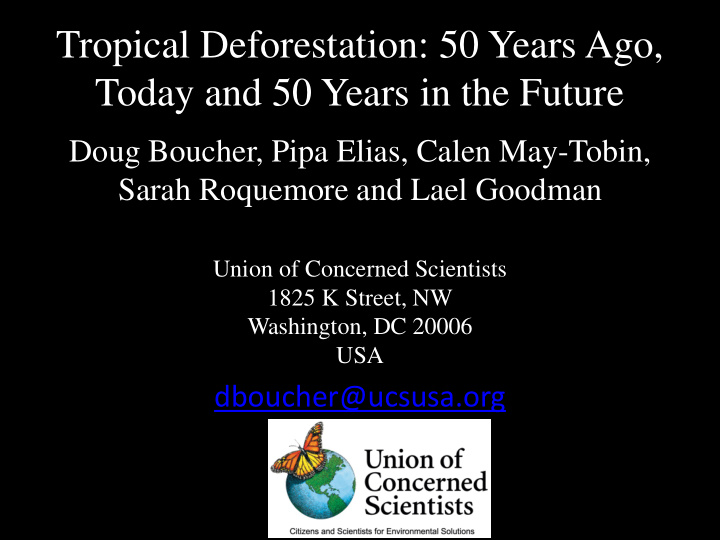



Tropical Deforestation: 50 Years Ago, Today and 50 Years in the Future Doug Boucher, Pipa Elias, Calen May-Tobin, Sarah Roquemore and Lael Goodman Union of Concerned Scientists 1825 K Street, NW Washington, DC 20006 USA dboucher@ucsusa.org
Goal of this presentation: • To look at past, current and future deforestation, and the forces driving it: – 50 years ago, when the ATBC/OTS was founded – Today – Possible changes in the next 50 years
The 1960s – the postwar peak in global population growth Source: U.N. Population Division (2009) World Population Prospects . Estimates based on data for 1950-2010, projections for 2010- 2050 Red dashed line (TFR 2.1) indicates zero long-term growth rate
Main drivers of deforestation in the 1960s and 1970s • Small-scale farmers and ranchers moving into humid tropical forest regions, e.g.: – The eastern side of Central America – Amazonia – The outer islands of Indonesia
Government policies concerning humid tropical forests • Large-scale colonization and resettlement programs – Related to the Cold War and pressure for land reform – Tropical forests as “safety valves” – National sovereignty issues
Greenhouse gas emissions In the late twentieth century, there was a fairly high and consistent rate of emissions from land use change, most of which was due to tropical Data from Global deforestation Carbon Budget, 2011
Important changes in the 21 st Century • New drivers of deforestation • Changes in demography • Recognition of the importance of deforestation in relation to climate and GHG emissions
New global drivers • Commercial agriculture and forestry, not small-scale farmers • Export markets and urban demand • Main commodities involved: – Soy – Beef – Palm oil – Timber – Pulp and paper Rudel 2007, Rudel et al. 2009, DeFries et al. 2010, Lambin & Meyfroidt 2011
Changes in demography • Population growth rates much lower, including in tropical forest nations: • Rural populations no longer growing in Brazil, Indonesia, etc. • Global population expected to level off in later 21 st - century • Rapid urbanization
Awareness of the relation between deforestation and global warming • About 15% of global emissions in the 1990s • A lower percentage now, although much of the change is due to an increased denominator (continued increase in fossil fuel emissions) • Reducing deforestation came to be seen as an inexpensive way to mitigate climate change
Recent success in reducing deforestation • 75% drop in the Amazon of Brazil in six years • With continued growth and profitability of the soy and beef industries, previously the main drivers Boucher et al. 2011, Root of the Problem ; Data from INPE and FAO
An example: Costa Rica • Deforestation and then forest restoration in the Chorotega region of northwestern Costa Rica • Calvo-Alvorado et al. 2009, Forest Ecology and Management
Reductions in deforestation in other tropical countries as well Examples: • Mexico • Peru • Gambia • Dominican Republic • Vietnam • Indonesia (according to official data)
Result: a substantial drop in emissions from land use change From a mean of 5.25 Gt CO 2 /year from 1960 to 1999, emissions have fallen to 3.25 Gt CO 2 /year in 2010 Data from Global Carbon Budget, 2011
Fifty years in the future what might be possible?
Goal of zero net deforestation by 2020 • Deforestation rate reduced to a level matched by natural forest restoration • Emissions due to deforestation balanced by sequestration due to revegetation Figure from Aide et al. 2013 Biotropica
Important issues 50 years in the future • Forest degradation becoming increasingly important (Morton et al. 2013) • Restoration not only of carbon, but also of biodiversity • Comprehensive land use policies could/should become a standard development pathway for tropical countries • Research by ATBC members can help address these issues
Thanks to: ClimateWorks Foundation Climate and Land Use Alliance European Federation for Transport and Environment Linden Trust for Conservation Packard Foundation Liz Clark, Estrellita Fitzhugh, Katherine Lininger, Earl Saxon and Stu Sheppard This UCS report and others can be downloaded at: www.ucsusa.org/whatsdrivingdeforestation and at www.ucsusa.org/forests
Recommend
More recommend